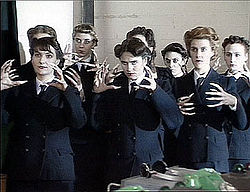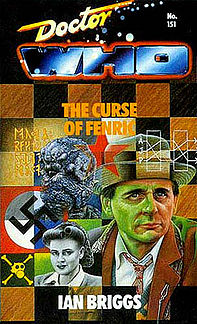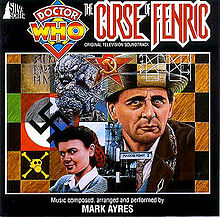- The Curse of Fenric
-
154[1] – The Curse of Fenric Doctor Who serial 
Haemovore converts prepare to feast.Cast Others- Dinsdale Landen — Dr Judson
- Alfred Lynch — Commander Millington
- Stevan Rimkus — Captain Bates
- Marcus Hutton — Sgt Leigh
- Christien Anholt — Perkins
- Tomek Bork — Captain Sorin
- Peter Czajowski — Sgt Prozorov
- Marek Anton — Vershinin
- Mark Conrad — Petrossian
- Nicholas Parsons — Rev Wainwright
- Janet Henfrey — Miss Hardaker
- Joann Kenny — Jean
- Joanne Bell — Phyllis
- Anne Reid — Nurse Crane
- Cory Pulman — Kathleen Dudman
- Aaron Hanley — Baby Audrey
- Raymond Trickett — Ancient Haemovore
Production Writer Ian Briggs Director Nicholas Mallett
John Nathan-Turner (uncredited)Script editor Andrew Cartmel Producer John Nathan-Turner Executive producer(s) None Production code 7M Series Season 26 Length 4 episodes, 25 minutes each Originally broadcast 25 October–15 November 1989 Chronology ← Preceded by Followed by → Ghost Light Survival The Curse of Fenric is a serial in the British science fiction television series Doctor Who, which was first broadcast in four weekly parts from 25 October to 15 November 1989. Unusually, two further versions of this story exist: the 1991 video release incorporated about six minutes of extra material into the original narrative, and the 2003 DVD included a 'Special Edition' edited into a single movie-length feature, with new special effects, re-editing of some scenes, and twelve minutes of unbroadcast footage.
Contents
Plot
The Doctor and Ace arrive at a British naval installation near Maiden's Point on the Northumbrian coast during World War II. Befriending the base personnel, they learn that the base, run by Commander Millington, is being used as a listening post to intercept and translate German coded messages using the ULTIMA supercomputer, and to stockpile a supply of a lethal nerve gas. Meanwhile, wheelchair-bound Dr. Judson has also been using ULTIMA to help decipher Viking runes found in catacombs beneath the base, warning of a being called Fenric, which has attracted Millington's attention believing he can gain Fenric's power. Outside the base, the Doctor and Ace discover a covert Russian troop, led by Captain Sorin, who are seeking to capture ULTIMA for themselves; the Doctor warns them to stay low, while Ace and Sorin become smitten for each other.
The Doctor and Ace find a glowing Oriental vase, a treasure captured by the Vikings and left in the catacombs, but it is taken by Millington when they return to the base. As Millington and Judson prepare to use ULTIMA to decipher the writings on the vase, vampire-like Haemovores begin to emerge from the sea, attack and convert the English and Soviet troops and other residents into more Haemovores. When Judson runs ULTIMA with the vase, energy strikes Judson, and he becomes infused with Fenric. Fenric begins to give orders to the Ancient One, an old Haemovore in control of the other monsters, to continue to assault anyone in their path. Ace is able to warn one of the WRNS, Kathleen, in time for her to escape with her newborn child, Audrey.
The Doctor reveals he has previously faced Fenric, an ancient evil since the dawn of time, besting him by challenging him at a chess problem. Arranging another chess problem in the same room where the nerve gas has been stockpiled, the Doctor is able to delay Fenric while he runs off to seek a more permanent solution. Sorin, the last remaining member of his squad, enters the room and prepares to shoot Fenric, but Fenric reveals that Sorin is one of his "wolves", having descended from the Vikings that carried the cursed vase to the English shores, and takes over his body. When Ace returns to the room, she unwittingly helps Fenric, in Sorin's body, to solve the chess problem. The Doctor arrives too late, as Fenric can no longer be stopped. Fenric orders the Ancient One to attack the Doctor, but a psychic barrier created by Ace's trust in the Doctor prevents the Ancient One from acting. The Doctor is forced to reveal to Ace that she too is one of Fenric's pawns, as it was he that created the time storm that transported her to the alien world where she met the Doctor the first time.[2] Furthermore, by saving Kathleen and Audrey, she has assured that the cycle remains unbroken, as Audrey will grow up to become Ace's mother whom she despises. Ace's faith shatters, causing the psychic barrier to drop, but instead of attacking the Doctor, the Ancient One grabs Fenric, pulls him into a sealed chamber and releases a lethal dose of the gas. The chamber explodes, killing them both. As the Doctor and Ace recover along the shore, Ace takes a moment to contemplate why she hates her mother and to absolve her irrational fear of the water before she and the Doctor return to the TARDIS.
Continuity
- The episode appears to be set in 1943 (see the Chronology for details).
- The Doctor chants the names of his former companions to ward off the Haemovores. Most of the names he chants are inaudible, but a few can be made out, including Susan, Barbara, Vicki and Steven.
- Ace mentions an old house in Perivale. This was originally intended as a foreshadowing of Ghost Light; the resequencing of the broadcast schedule, however, altered it into an apparent reference to a past story.
- Similarly, the Doctor's new wardrobe for season 26 was intended to be hidden for a large part of this story by a long coat, setting up a dramatic revelation when he removed the coat. These plans were also dashed by the rescheduling.[3]
- The Seventh Doctor and Ace return to World War II in the audio play Colditz, co-starring David Tennant.
- Like Ace, Luke Smith travels back in time in The Temptation of Sarah Jane Smith and meets his infant mother and young maternal grandmother. Their respective grandmothers dash off in automobiles to save their daughters, and both grandfathers' deaths are revealed.[citation needed]
- When Ace dismisses Captain Sorin's admiration that she wears a Soviet star patch on her jacket, by telling him that it is a cheap copy she bought, he gives her a pin-on Red Army insignia from his own uniform to wear. That badge is still pinned to the left breast of her jacket in Survival.
- The Eleventh Doctor is also forced to break a companion's faith in him to save their lives in The God Complex, when he is forced to break the faith that his companion Amy Pond has in him to starve an alien being that feeds on strong faith to death.
Production
Serial details by episode Episode Broadcast date Run time Viewership
(in millions)"Part One" 25 October 1989 24:23 4.3 "Part Two" 1 November 1989 24:09 4.0 "Part Three" 8 November 1989 24:11 4.0 "Part Four" 15 November 1989 24:16 4.2 [4][5][6] Pre-production
Writer Ian Briggs based the character of Dr Judson on Alan Turing. (The "ULTIMA machine" of the story is based on the real Enigma machine.) In an interview for the DVD release of this story, Briggs said that since at that time it was not considered appropriate to depict a character's struggle with homosexuality in a family programme, he transformed Turing's frustration at being unable to express his true sexual identity into Judson's frustration at being crippled. In the same interview, Briggs stated that he intended to suggest that both Judson and Millington were gay and had a shared past, although this was not realised in the finished programme.
This story was originally going to be titled The Wolves of Fenric (and before that, Wolf-Time). Fenric does refer to his servants as his "wolves" (and wolves have a strong link to Norse mythology). However, Nathan-Turner felt that as the "wolves" connection was not revealed until quite late in the story, the title would not initially make sense to the audience.[7].
Although there are several references in the story to the Norse belief in a final battle at the end of the world, the word Ragnarok was removed from the script to avoid confusion with the Gods of Ragnarok from the previous season's The Greatest Show in the Galaxy.
This story is the second in what some have called the "Ace Trilogy", a three-story arc that explores elements of Ace's past before she met the Doctor. This was not an intentional trilogy, since "Fenric" was originally intended to start the season and be followed by Battlefield, Survival and then Ghost Light.
Production
- The Curse of Fenric was originally to have been shot, as with most Doctor Who serials, as a mixture of studio interiors and location exteriors. However, after reading the script, director Nicholas Mallett persuaded producer John Nathan-Turner that given the settings involved, the serial could be made more effective and realistic by shooting the entire production on location, to which Nathan-Turner eventually agreed.[7]
- Shooting on the serial went over-length to such a degree that consideration was briefly given to editing the story into five rather than four episodes. However, Ian Briggs strongly opposed this, feeling that the narrative flow would be badly disrupted.
Cast notes
- Marek Anton, who played the Destroyer in Battlefield, is seen here in person as the Russian soldier Vershinin.
- The infant Audrey was the son of the proprietors of the Bush Hotel on Shepherd's Bush Green, familiar to the production team as it was near the Doctor Who offices.[8]
- This serial features guest appearances from Dinsdale Landen as Dr Judson and Nicholas Parsons as Reverend Wainwright. See also List of guest appearances in Doctor Who.
- Two of the Haemovores in this story are played by Sylvester McCoy's sons: Sam and Joe Kent-Smith.
- One of the Haemovores was played by Ian Collins.
- Anne Reid returned to Doctor Who as Florence Finnegan in the Tenth Doctor episode "Smith and Jones", ironically playing an actual vampire in this story.
- Actress Janet Henfrey was a schoolfriend of Sophie Aldred's mother. Her character of Miss Hardaker in this serial was modelled on the part she played, again as a school teacher, in two Dennis Potter dramas: Stand Up, Nigel Barton (1965) and The Singing Detective (1986).
- Sylvia Syms, who played the character Mrs Pritchard in Ghost Light, was originally offered the part of Miss Hardaker.
In print
A novelisation of this serial, written by Ian Briggs, was published by Target Books in November 1990. The novel features additional character information absent from the serial and an epilogue featuring an older Ace after she has left the Doctor. This formed part of the basis for Ace's departure in Kate Orman's Virgin New Adventures novel Set Piece, where she chooses to stay in Paris to monitor a time rift and at some point has a relationship with one of Captain Sorin's ancestors.
Doctor Who book 
The Curse of Fenric Series Target novelisations Release number 151 Writer Ian Briggs Publisher Target Books Cover artist Alister Pearson ISBN 0-426-20348-8 Release date 15 November 1990 Preceded by ' Followed by ' VHS, DVD and CD releases
- The story was released on VHS in 1991. The release included about six minutes worth of the extra scenes.
- This story was released on DVD in the UK in October 2003 in a two-disc set as part of the Doctor Who 40th Anniversary Celebration releases. This consisted of the original four broadcast episodes, plus a 'Special Edition' edited into one movie-length adventure including twelve minutes of unbroadcast material. This version has reworked special effects and music arranged by Mark Ayres based on notes written up by himself and the late Nicholas Mallett; it also sees several scenes re-edited to produce a more coherent narrative.
Soundtrack release
Doctor Who: The Curse of Fenric 
Soundtrack album by Mark Ayres Released 1991 Genre Soundtrack Length 72:09 Label Silva Screen Mark Ayres chronology Doctor Who: The Curse of Fenric
(1991)Doctor Who: The Greatest Show in the Galaxy
(1992)Doctor Who soundtrack chronology The Doctor Who 25th Anniversary Album
(1988)Doctor Who: The Curse of Fenric Doctor Who: The Greatest Show in the Galaxy
(1991)Mark Ayres's music from this story was released on CD in 1991 by Silva Screen Records.[9][10][11]
Track Listing
- Introduction: "Doctor Who"
- The Boats
- Beach-Head and Rat-Trap
- Sealed Orders
- Eyes Watching
- Commander Milligan
- Viking Graves
- Maiden's Point
- The Translations
- Audrey and Milligan's Office
- The Curse of Fenric
- High Stakes
- The Crypt
- The Ambush
- The Well of Vergelmir
- The Ultima Machine
- Dangerous Undercurrants
- The Seduction of Prozorov
- Half-Time Score
- Exit Miss Hardaker/The Vicar and the Vampires
- Sopt the Machine!
- The Haemovores
- The Battle for St. Jude's
- The Mineshaft
- Sealing the Hatch
- House Guests
- The Telegram
- Evil from the Dawn of Time
- The Storm Breaks
- Ancient Enemies
- Shadow Dimensions
- Chemical Grenade
- The Great Serpent
- Pawns in the Game
- Kathleen's Escape
- The Wolves of Fenric
- Black Wins, Time Lord!
- The Final Battle
- Epilogue: "Doctor Who"
References
- ^ From the Doctor Who Magazine series overview, in issue 407 (pp26-29). The Discontinuity Guide, which counts the four segments of The Trial of a Time Lord as four separate stories and also counts the unbroadcast serial Shada, lists this story as number 158. Region 1 DVD releases follow The Discontinuity Guide numbering system.
- ^ Dragonfire
- ^ Doctor Who: "The Curse of Fenric", DVD Information Text. Ed. Martin Wiggins.
- ^ Shaun Lyon et al. (2007-03-31). "The Curse of Fenric". Outpost Gallifrey. Archived from the original on 2008-06-11. http://web.archive.org/web/20080611072719/http://www.gallifreyone.com/episode.php?id=7m. Retrieved 2008-08-30.
- ^ "The Curse of Fenric". Doctor Who Reference Guide. http://www.drwhoguide.com/who_7m.htm. Retrieved 2008-08-30.
- ^ Sullivan, Shannon (2007-08-07). "The Curse of Fenric". A Brief History of Time Travel. http://www.shannonsullivan.com/drwho/serials/7m.html. Retrieved 2008-08-30.
- ^ a b The Curse of Fenric at Doctor Who: A Brief History Of Time (Travel)
- ^ BBC - Doctor Who - New Years Day
- ^ (1991) Album notes for Doctor Who: The Curse of Fenric [CD Booklet]. Silva Screen (FILMCD 087).
- ^ Ayres, Mark. "Mark Ayres - Doctor Who Incidental Music". http://ourworld.compuserve.com/homepages/Mark_Ayres/DocWho.htm. Retrieved 2008-10-05.[dead link]
- ^ "Millenium Effect". http://www.millenniumeffect.co.uk/audio/composed-silva.php. Retrieved 2008-10-05.
External links
- The Curse of Fenric at BBC Online
- The Curse of Fenric on TARDIS Index File, an external wiki
- The Curse of Fenric at the Doctor Who Reference Guide
- Doctor Who Locations - The Curse of Fenric
Reviews
- The Curse of Fenric reviews at Outpost Gallifrey
- The Curse of Fenric reviews at The Doctor Who Ratings Guide
- The Curse of Fenric DVD Special Edition reviews at The Doctor Who Ratings Guide
Target novelisation
- The Curse of Fenric (novelisation) reviews at The Doctor Who Ratings Guide
- On Target — The Curse of Fenric
Doctor Who season 26 serials Categories:- Seventh Doctor serials
- Doctor Who pseudohistorical serials
- 1989 television episodes
- Vampires in film and television
Wikimedia Foundation. 2010.
